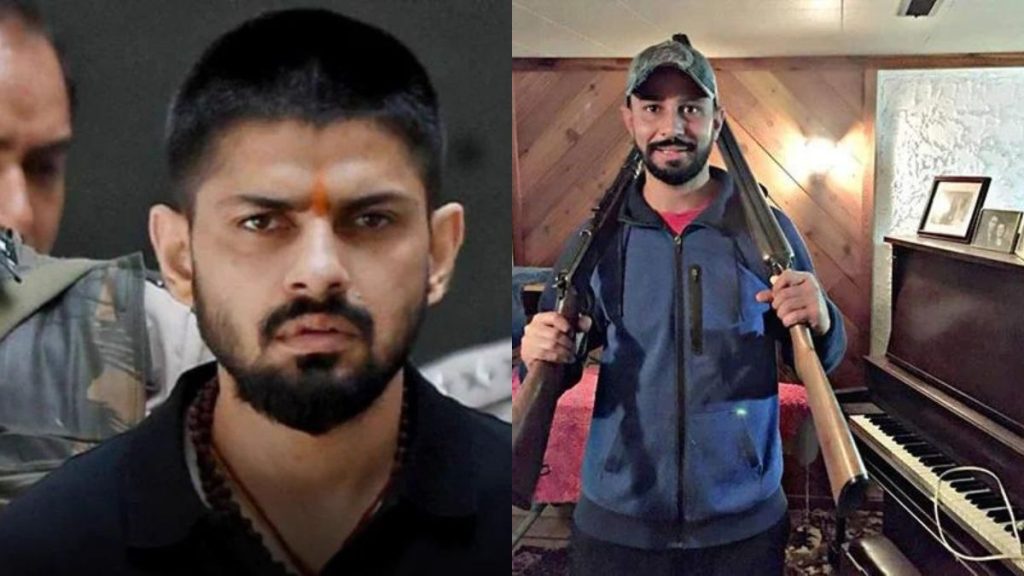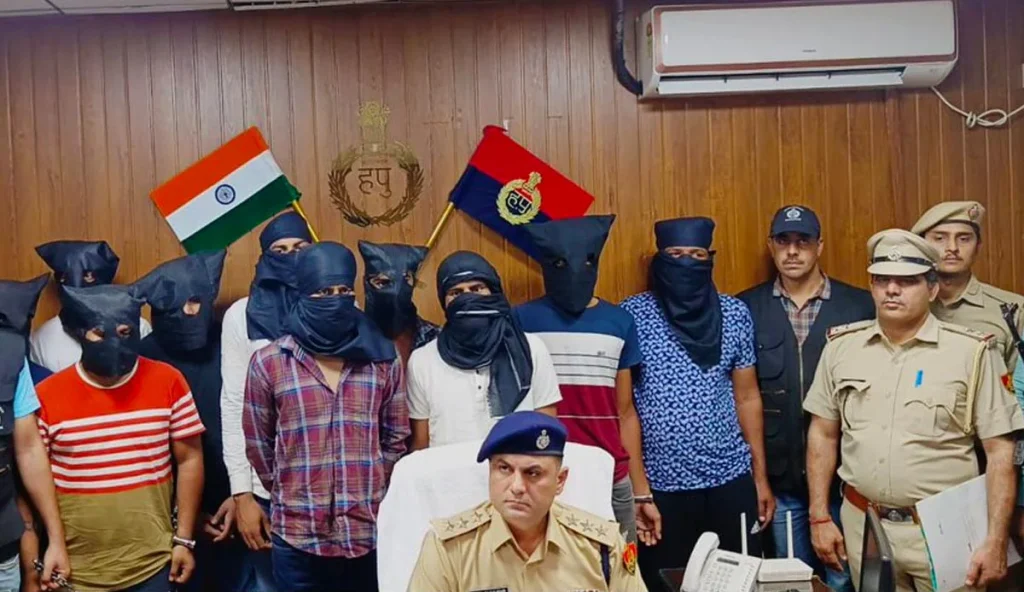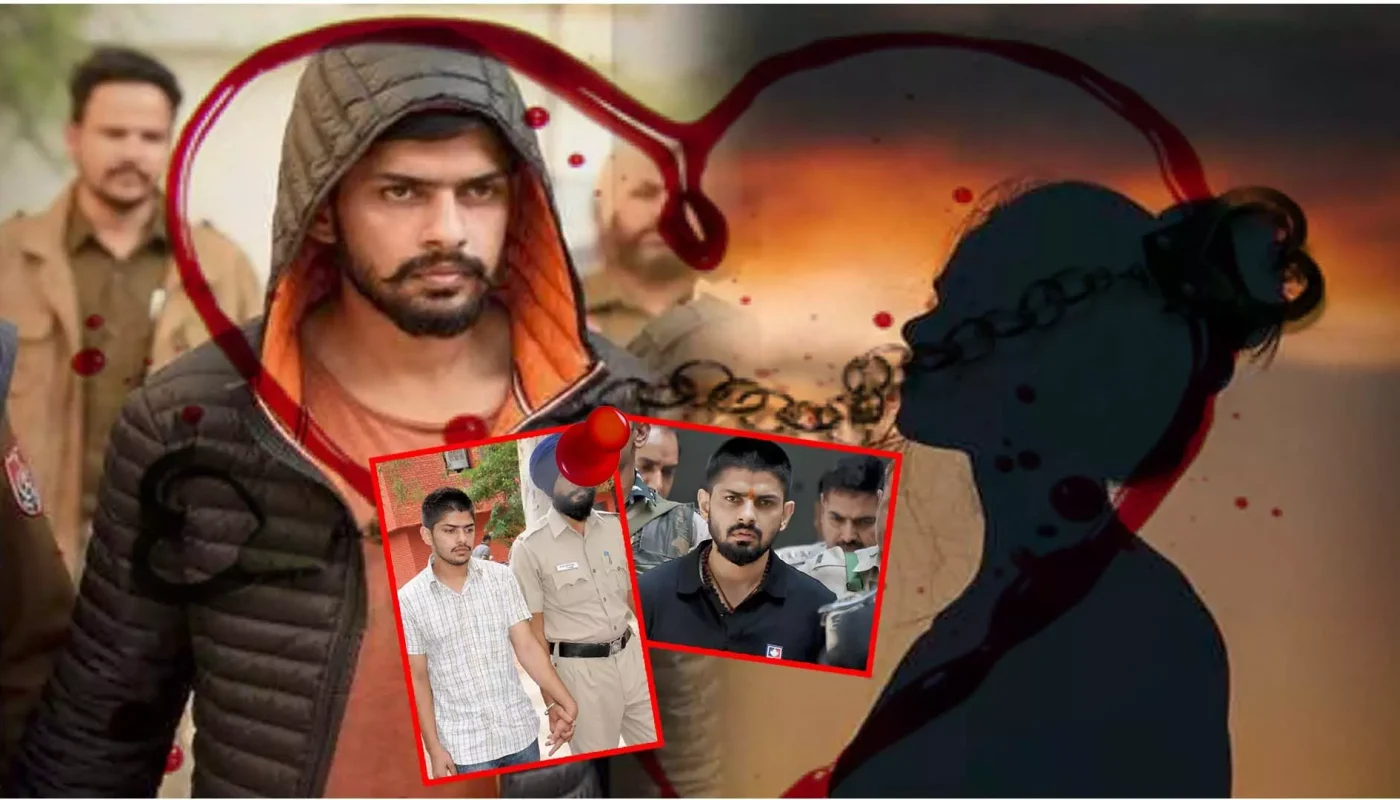Lawrence Bishnoi’s transformation from a college student to one of North India’s most notorious gangsters is a stark emblem of the dark intersections between socio-political issues and organized crime in India. Originating from a humble farming background in Punjab, Bishnoi has become infamous for many crimes across several states, including Punjab, Haryana, Rajasthan, and Delhi. His story is not merely one of criminal activities but highlights the deeper societal and economic disparities, leveraging caste politics and youth disillusionment to cement his position in the underworld.
Bishnoi’s adept use of brute force and social media to expand his influence underscores the complex challenges facing law enforcement and society in addressing the roots and ramifications of organized crime. This brief overview sets the stage for a deeper dive into the life, operations, and impact of Lawrence Bishnoi, reflecting on the broader struggle against organized crime in India.
Lawrence Bishnoi Background
Born into a farming family in Punjab’s Abohar, Lawrence Bishnoi’s journey from a bright student to one of North India’s most feared gangsters is a tale of ambition turned nefarious. His descent into the criminal world began at DAV College, Chandigarh, where involvement in aggressive student politics laid the groundwork for his future in organized crime. These early years were crucial in shaping Bishnoi’s understanding of power dynamics, loyalty, and the instrumental role of caste politics, which would later underpin his criminal network.
The transition from minor offenses to major criminal activities was swift, as Bishnoi’s operations expanded beyond Punjab to encompass extortion, kidnapping, drug trafficking, and murder across several states. His rise to power is a stark reflection of the complex mesh of socio-political issues, personal ambition, and the societal backdrop that often blurs the lines between politics and crime in India. Bishnoi’s story illustrates how deep-rooted societal issues can propel individuals down a path of infamy, marking them as products of their circumstances as much as architects of their own fate.

Rise to Notoriety
Lawrence Bishnoi’s ascent to notoriety in the Indian underworld is a narrative marked by strategic cunning and brutal force. Following his initial foray into crime during his college years, Bishnoi’s activities quickly escalated from campus-based skirmishes to major criminal operations. His transition was fueled by a combination of personal ambition and the utilization of caste-based networks, which provided a steady base of support and loyalty within his community.
1) Expansion of Criminal Activities
Bishnoi’s criminal repertoire expanded to include a wide range of illicit activities. His operations began to cover extortion, kidnapping for ransom, illegal arms trafficking, and the lucrative drug trade, which is rampant in Punjab and the surrounding regions. His involvement in high-profile murders and attempts on the lives of rivals and law enforcement officers cemented his reputation as a formidable and ruthless gang leader.
2) Building the Gang
As his notoriety grew, so did the size and reach of his gang. Bishnoi meticulously built a network of loyal followers, drawn from among the youth of his and neighboring communities, many of whom were disillusioned by the lack of employment opportunities and attracted to the allure of quick wealth and power. He leveraged social media and modern communication tools to recruit, organize, and execute criminal activities, making his operations both sophisticated and elusive.
3) Infamous Feuds and Criminal Rivalries
Bishnoi’s rise was not without its challenges. His path to power was marked by violent feuds with rival gangs, which often resulted in public shootouts and killings. These confrontations not only demonstrated his gang’s lethal capabilities but also served as a deterrent to potential challengers. His name became associated with several high-profile criminal cases, which drew significant media attention and further amplified his notoriety.
4) Law Enforcement Challenges
The law enforcement’s attempts to curb Bishnoi’s activities were met with limited success. His adept use of technology, along with the gang’s deep-rooted local support and the cross-state nature of his operations, made it difficult for the police to track and capture him. Bishnoi’s ability to evade capture, coupled with his reputation for exacting revenge on those who opposed him, made many wary of taking action against him.
Lawrence Bishnoi’s rise to notoriety is a testament to his strategic acumen and ruthlessness. His journey from a college student to one of the most feared gangsters in North India underscores the challenges facing law enforcement in dealing with organized crime, which is deeply intertwined with social and economic issues. Bishnoi’s story is not just one of personal ambition but reflects broader systemic failures that allow such figures to emerge and thrive.
The Bishnoi Gang’s Operations
The operations of the Bishnoi gang under Lawrence Bishnoi’s leadership are characterized by a broad spectrum of criminal activities, leveraging both traditional methods of organized crime and modern technological advancements. His gang’s operations span across several Indian states, making it a formidable network with a significant impact on regional security and law enforcement efforts.
1) Extortion and Protection Rackets
A cornerstone of the Bishnoi gang’s operations is extortion, targeting businessmen, traders, and even celebrities for protection money. These activities are not only lucrative but also serve to expand the gang’s influence by instilling fear and securing loyalty from the local business community. Protection rackets are run with precision, ensuring a steady flow of income to fund other illegal activities.
2) Drug Trafficking
Punjab’s proximity to the Golden Crescent makes it a vulnerable point for drug trafficking, an operation in which the Bishnoi gang is deeply involved. The gang capitalizes on this geographical advantage to smuggle heroin, opium, and synthetic drugs, distributing them across the state and beyond. This not only generates enormous profits but also contributes to the socio-economic issues plaguing the region, such as youth drug addiction.
3) Arms Smuggling
The gang’s involvement in illegal arms trading ensures a continuous supply of weapons for their operations and for sale within the criminal underworld. This aspect of their operations supports their extortion and protection rackets, as well as their capacity to engage in violent confrontations with rival gangs and law enforcement.
4) Contract Killings and Intimidation
Lawrence Bishnoi’s gang is notorious for contract killings, offering their lethal services for settling scores within the criminal underworld or for anyone willing to pay their price. This has led to a series of high-profile murders and assassination attempts that have not only demonstrated their ruthlessness but also deterred opposition. Intimidation tactics are frequently employed against witnesses and rivals, further cementing their grip on the territories they control.
5) Use of Technology and Social Media
A distinctive feature of the Bishnoi gang’s operations is their adept use of technology and social media. These platforms are utilized for the coordination of criminal activities, recruitment of new members, and even for flaunting their lifestyle and crimes, which adds to their notoriety and influence among the youth. Encryption and secure communication channels make it challenging for law enforcement agencies to intercept and prevent their criminal plans.
6) Cross-State Operations
The gang’s activities are not confined to Punjab; they have extended their reach to Haryana, Rajasthan, Delhi, and beyond. This expansion has been facilitated by forming alliances with local criminals and exploiting inter-state jurisdictional challenges faced by law enforcement agencies. The cross-state nature of their operations complicates tracking and capturing gang members, making the Bishnoi gang a persistent challenge for authorities.
Challenges in Law Enforcement
The challenges law enforcement faces in curbing the activities of the Bishnoi gang, led by Lawrence Bishnoi, are multi-faceted and complex. These challenges stem from the gang’s sophisticated operational strategies, technological savvy, and deep-rooted community ties, among other factors. Here’s an overview of the major hurdles in tackling this criminal network:
1) Inter-State Coordination
The Bishnoi gang operates across several Indian states, including Punjab, Haryana, Rajasthan, and Delhi, exploiting the jurisdictional limitations of state police forces. This cross-state operation complicates efforts to track and apprehend gang members, requiring a level of inter-state coordination that is often difficult to achieve due to bureaucratic hurdles and lack of real-time information sharing.
2) Technological Advancements
The gang’s adept use of technology for communication, coordination, and execution of their criminal activities presents a significant challenge. They leverage encrypted messaging apps, social media platforms, and other digital tools to stay ahead of law enforcement agencies. This makes it difficult for the police to intercept communications, gather intelligence, and prevent crimes before they occur.
3) Community Support and Fear
In many areas, the Bishnoi gang enjoys a degree of support from local communities, partly due to Lawrence Bishnoi’s caste-based appeal and the gang’s portrayal as protectors of their community’s interests. This local support can manifest as reluctance to cooperate with law enforcement, providing safe havens for gang members, and even obstructing police operations. Additionally, the gang’s reputation for brutality instills fear in those who might consider opposing or testifying against them.
4) Witness Intimidation
A critical challenge in prosecuting members of the Bishnoi gang is their intimidation of witnesses. The fear of retaliation discourages witnesses from coming forward or cooperating with the authorities, leading to weakened cases and difficulty in securing convictions. This tactic effectively undermines the legal process and allows gang members to evade justice.
5) Legal and Bureaucratic Delays
The Indian legal system is often hampered by delays and a backlog of cases, which can be exploited by the Bishnoi gang and similar criminal organizations. The slow pace of trials, combined with the possibility of bail for accused individuals, allows gang members to continue their operations even when under legal scrutiny. This inefficiency diminishes the deterrent effect of law enforcement actions.
6) Lack of Specialized Units
The specific challenges posed by organized crime groups like the Bishnoi gang require specialized law enforcement units trained in modern investigative and operational techniques. However, a shortage of such units, equipped to deal with the nuances of organized crime, cyber operations, and financial crimes, limits the effectiveness of police efforts against sophisticated criminal networks.
7) Addressing the Root Causes
Finally, addressing the criminal activities of the Bishnoi gang and similar entities is not just about law enforcement; it also involves tackling the socio-economic conditions that foster such organizations. Issues like unemployment, drug addiction, and social disenfranchisement need to be addressed to undermine the recruitment base of these gangs.

Legal and Social Implications
The operations of the Bishnoi gang, led by Lawrence Bishnoi, present significant legal and social challenges in India. Their widespread criminal activities, from violence to drug trafficking, not only test the limits of the legal system but also erode trust and cohesion within communities.
1) Legal Challenges
- Judicial Strain: The gang’s crimes contribute to an already burdened judicial system, leading to trial delays and questioning the efficiency of justice delivery.
- Prosecution Difficulties: Overcoming witness intimidation and gathering sufficient evidence against gang members are major hurdles, affecting the conviction rate and public confidence in legal processes.
- Need for Legal Reforms: The rise of such criminal networks underscores the urgency for legal reforms, particularly in organized crime legislation, witness protection, and cybercrime laws.
2) Social Consequences
- Community Impact: The gang’s activities foster fear and mistrust, disrupting social harmony and community cooperation with law enforcement.
- Influence on Youth: The glorification of gang life, especially on social media, risks attracting young individuals to criminal paths, perpetuating crime cycles.
- Public Health and Economy: Drug trafficking exacerbates public health issues, while extortion practices hinder local business growth and economic development.
3) Addressing the Implications
Efforts to mitigate these challenges require a multifaceted approach:
- Enhancing judicial efficiency for faster trials.
- Implementing robust witness protection to secure convictions.
- Community outreach and youth engagement programs to deter gang recruitment.
- Public health initiatives to combat drug abuse and support economic measures to bolster local businesses.
In summary, tackling the Bishnoi gang’s impact demands comprehensive strategies that combine legal reform, community engagement, and socio-economic development, aiming to restore public trust and dismantle the roots of organized crime.
Strategies for Combating Organized Crime
Tackling organized crime, such as the network led by Lawrence Bishnoi, demands a strategic and holistic approach that addresses both the operations of these groups and the underlying conditions that foster their growth. Here’s a condensed overview of effective strategies:
1) Inter-Agency Cooperation: Enhanced collaboration between different law enforcement agencies and international partnerships is crucial for sharing intelligence and coordinating actions across jurisdictions to combat organized crime more effectively.
2) Technological Advancements: Investing in technology and intelligence-gathering tools can significantly aid in tracking criminal activities, analyzing data, and monitoring financial transactions to disrupt organized crime networks.
3) Community Engagement: Building strong relationships with communities through outreach programs can help in gathering vital intelligence and reducing the local support base for criminal organizations.
4) Legal and Judicial Reforms: Updating legal frameworks to address modern organized crime and ensuring swift prosecution can serve as a deterrent. Specialized courts for organized crime can improve trial efficiency.
5) Witness Protection: Robust witness protection programs are essential to encourage individuals to come forward with information, ensuring their safety and securing convictions against criminal leaders.
6) Socio-Economic Interventions: Addressing factors like unemployment and poverty through education and employment opportunities can reduce the appeal of criminal organizations, cutting off their recruitment base.
7) Focused Operations on Leaders: Targeted operations to dismantle the leadership structure of criminal networks can significantly disrupt their activities. These should aim at the financial and logistical aspects of the organization.
8) Global Collaboration: Forging international collaborations for joint operations and legal assistance is key to addressing the global nature of organized crime today.
Implementing these strategies requires a coordinated effort from law enforcement, the legal system, communities, and international partners to effectively combat organized crime and mitigate its impact on society.
Must Read:
Conclusion
Combating organized crime, such as the network led by Lawrence Bishnoi, requires a comprehensive strategy that spans beyond law enforcement to include community involvement, legal reforms, and tackling socio-economic issues. It’s a collective effort that involves not just the police but also the wider community, legal systems, and international cooperation. Success in this fight hinges on addressing both the symptoms and the root causes of organized crime. By integrating advanced technology, fostering community relations, and implementing socio-economic initiatives, we can work towards a safer, more secure society. The challenge is complex, but with coordinated and sustained efforts, it’s possible to make impactful progress against organized criminal activities.
